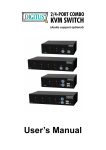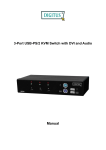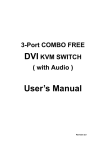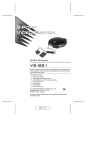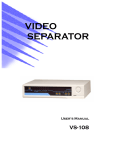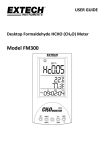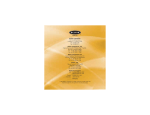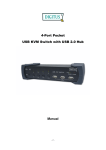Download USER¡¦S MANUAL
Transcript
2-Port / 4-Port KVM SWITCH User’s Manual Version 2.0 / 060914 Model Specifications 2-Port model Audio model PC Ports HDB-15 (VGA+USB+2 PS/2) Audio (mic/speaker) Console PS/2 Keyboard PS/2 mouse Video HDB-15 USB Keyboard USB mouse Audio (mic/speaker) KCF-121 √ KCB-121 √ KCF-121A √ √ KCB-121A √ √ 2 2 2 2 √ √ √ 2 √ √ √ √ 2 √ √ √ √ √ √ √ √ KCB-121 KCB-121A KCF-121 KCF-121A 2/2 √ √ √ Model Specifications 4-Port model Audio model PC Ports HDB-15 (VGA+USB+2 PS/2) Audio (mic/speaker) Console PS/2 Keyboard PS/2 mouse Video HDB-15 USB Keyboard USB mouse Audio (mic/speaker) KCF-141 √ KCB-141 √ KCF-141A √ √ KCB-141A √ √ 4 4 4 4 √ √ √ 4 √ √ √ √ 4 √ √ √ √ √ √ √ √ KCB-141 KCB-141A KCF-141 KCF-141A 3/3 √ √ √ 1. Introduction The 2-Port/4-Port KVM Switch are high quality and durable systems that will allow you to control 2/4 host computers (or servers) by connecting to PS/2 or USB connectors from one console (PS/2 / USB Mouse, PS/2 / USB Keyboard, and Monitor). 1.1 Features Controls 2 / 4 computers from a single console (Keyboard/Mouse) over either PS/2 or USB connections The PC ports support Windows, Linux, Mac OS9/OSX, Sun Microsystems. Keyboard emulation on each un-selected PC to allow it to boot normally without a keyboard error Hot-swap support. All devices connected to the KVM switch can be added or removed at any time without shutting the unit down. Support 2 types of switching: (1) Hardware Push Button control, (2) Hot key command control from PS/2 or USB keyboard. Provide Auto-scan function to alternate video between computers in a preset interval. Provide LED display for PC status monitoring. Supports VGA resolutions up to 2048 x 1536. Provide Beeper during switching enabled. Self powered through PS/2 and/or USB connection Fully compliant with the USB 1.1/ 2.0 specification 1.2 Package Contents The product you purchased should contain the following equipment and accessories: One 2-Port /4-Port KVM Switch unit 2/4 combo 4-in-1 cables 2/4 sets of speaker+microphone cables. ( with Audio models ) Product CD (with operation manual) 4/4 2. Specifications 2.1 General Specification Number Of Computers Controlled 2 / 4 PC Port Selection Method Push Button and Hot-Key (PS/2 or USB Keyboard) LEDs Red for PC Selection Green for PC On-Line ready PC Connectors Video 2 / 4 x HDB -15 female ( VGA+USB+PS/2 signal combined ) Console Ports Speaker 2 / 4 audio female jacket (audio model) Microphone 2 / 4 audio female jacket (audio model) Keyboard KCF models - PS/2 mini-DIN + USB A type KCB models – PS/2 mini-DIN Mouse KCF models - PS/2 mini-DIN + USB A type KCB models – PS/2 mini-DIN Video 1 x HDB -15 female Speaker 1 x audio female jacket (audio model) Microphone 1 x audio female jacket (audio model) Auto-Scan Interval 5 ~ 250 Seconds DDC, DDC2 monitor Yes (Max. Resolution: 2048x1536) @ 85Hz Hot Swappable Yes Operating systems supported Windows 98SE/ME/2000/XP/2003 Server, Linux Mac OS9/OSX and Sun Micro System Device driver No Need Power By PS/2 and/or USB or External Power Adapter Cable Length 6 feet Dimensions (L X W X H) 2-Port : 14.0 x 8.5 x 4.5 cm (5.5 x 3.3 x 1.7 inches) 4-Port : 21.5 x 8.8 x 4.5 cm (8.5 x 3.4 x 1.7 inches) Unit Weight (1.80 Meter) 2-Port : 420~465 g 4-Port : 620~650 g Housing material Metal Operating Temperature 32~ 122oF Humidity 0%~80%RH 5/5 (0~ 50oC ) 2.2 Front Panel and Rear Panel The following figure illustrated 4-Port model with Audio and PS2 & USB console as example: Figure 2-1 Front Panel & Rear Panel 6/6 3. System Requirements Console A VGA, SVGA, Multisync monitor capable of the highest resolution PS/2 and/or USB Keyboard/Mouse Computers or Servers (PCs) The following equipment must be equipped with each computer or server. - A VGA, SVGA or Multisync card - Type A USB port or PS/2 6 pin mini-DIN for Keyboard and Mouse Cables The KVM Switch must be used with specific combo 4-in-1 cables. To purchase more cable sets, contact your dealer. Figure 3-1 Combo 4-in-1 cable 7/7 4. Installation LED Indicators: LED Name Selected On-Line On-Line Color State Red Green Green ON ON Blinking Function The PC port is selected. An active PC is connected. KVM is in auto-scan mode. Reset Switch : Press this push button switch to reset the KVM device. To push the switch, use a ball-point pen or a small stick. 4.1 Installation Precaution: 1. For users who want to connect PC over PS/2 interface, finish PS/2 connection before turning on the PC. PC is unable to detect PS/2 devices if PS/2 is not connected while booting. 2. When connecting Windows 98 PC, it is suggested to use PS/2 for the PC connections, because Windows 98 does not support installation at first time through USB HID installation driver. 3. Some old PCs can support USB ports during booting, but are required to open BIOS USB setting first. 4. The KVM switch does not support the USB keyboard which has built-in USB HUB. 5. The KVM switch can be powered by either PS/2 keyboard or USB connection. For some laptops, the PS/2 or USB power might not be enough to support the KVM switch and cause the KVM switch not working properly. Use external power adapter with 5V/0.3A~1A for the KVM power in this case. 6. For Windows 2000/2003/XP PC which is set to “need to be login with the password” and connects to KVM switch only over USB, it is suggested to complete the installation with KVM before logging out the windows. This will let the PC detect USB HID device and install the driver automatically for next booting. 8/8 Console connections: Plug USB or PS/2 keyboard, USB or PS/2 mouse arbitrarily and VGA video into the Console ports located on the front panel. A combination of USB mouse and PS/2 keyboard or a combination of PS/2 mouse and USB keyboard are all supported by the KVM Switch unit. System connections: Use KVM combo 4-in-1 cable (as shown in Figure 3-1) to connect an available KVM’s PC port to a computer’s video and USB or PS/2 ports. Improve monitor display quality: If you are using LCD monitor connected to the KVM switch with Audio and feel the display quality is not comfortable to you, you can apply monitor’s Auto-adjusting function to improve the display quality. 9/9 This KVM Switch with specific combo cable provides three connecting methods. 1. Plug Speaker, Microphone, USB, PS/2 ( keyboard/mouse) ports and VGA into PCs at same time, recommended in priority. ( Figure 4-1 ). Figure 4-1 Speaker, Microphone,PS/2 & USB and VGA connected at same time 2. Plug only Speaker, Microphone, PS/2 (keyboard / mouse) ports and VGA into PCs. ( Figure 4-2 ) Figure 4-2 Speaker, Microphone, PS/2 and VGA connected 10/10 3. Plug only Speaker, Microphone, USB and VGA into PCs. ( Figure 4-3 ). Figure 4-3 Speaker, Microphone, USB and VGA connected 5. Operations The 2/4-Port KVM Switch has the ability to switch the keyboard, video, mouse, audio, microphone simultaneously. Note: When using Hot Key, the keys must be pressed within 5 seconds; otherwise the Hot Key action is terminated. 5.1 Push Button on front panel Figure 5-1 Push Button for PC Port Selection Push the button directly to select the connected PC. 11/11 5.2 Hot-key operation ( Either PS/2 or USB Keyboard ) The hotkey command examples listed in following sections are based on the 4-Port models. The 2-Port models are equipped with the same design, but 2 PC selections only. Note: If your keyboard does not provide < Scroll Lock > button, use < Caps Lock > or <Num Lock > as leading key instead. 5.2.1 Leading key Selection Hot key commands: [Ctrl] -> [Ctrl] -> [Caps Lock] -> [Enter] to change leading key to [Caps Lock] [Ctrl] -> [Ctrl] -> [Num Lock] -> [Enter] to change leading key to [Num Lock] [Ctrl] -> [Ctrl] -> [Scroll Lock] -> [Enter] to change leading key to [Scroll Lock] Note: The default leading hotkey setting is [Scroll Lock]. After changing the leading hotkey setting, the new setting will take effect immediately until the KVM switch is powered off or reset. 5.2.2 PC Selection Hot key commands: [Scroll] -> [Scroll] -> [Enter] to select next higher PC port (not including Audio) [Scroll] -> [Scroll] -> [→] to select next higher PC port (not including Audio) [Scroll] -> [Scroll] -> [←] to select next lower PC port (not including Audio) [Scroll] -> [Scroll] -> [ 1 ] -> [Enter] to select PC1 (not including Audio) [Scroll] -> [Scroll] -> [ 2 ] -> [Enter] to select PC2 (not including Audio) [Scroll] -> [Scroll] -> [ 3 ] -> [Enter] to select PC3 (not including Audio) [Scroll] -> [Scroll] -> [ 4 ] -> [Enter] to select PC4 (not including Audio) 12/12 5.2.3 Auto-Scan Function Hot key command: [Scroll] -> [Scroll] -> [S] -> [Enter] to start Auto-scan operation Under Auto-scan operation, you can press any key to stop Auto-scan operation. Auto-scan function allows the KVM Switch alternates the connected PCs and displays them on the console monitor. Each PC is displayed in a time interval in a range of 5 ~ 250 seconds (The interval is adjustable) before switching to the next PC. During Auto-scan operation, the KVM Switch will ignore mouse operation. Pressing any key will stop the Auto-scan and the console monitor screen will jump back to the original PC. Adjustable scan time interval setting ( 5 ~ 250 sec. ) Hot key command: [Scroll] -> [Scroll] -> [S] -> <5 ~250 > [Enter] 5.2.4 Beeper Enable Hot key commands: [Scroll] -> [Scroll] -> [B] -> [Enter] to disable Beeper [Scroll] -> [Scroll] -> [B] -> [Enter] to enable Beeper The Speaker/Beeper’s default setting is “Enable”. While the switching connections are activated and Speaker/Beeper is in “Enable” status, the beeper has a short beep. 13/13 5.3 Audio ( Speaker / Microphone ) Selection – only work with Audio model 5.3.1 (PC+Audio) Combination Selection Hot key commands: [Scroll] -> [Scroll] -> [F1] -> [Enter] to select PC1 with its Audio [Scroll] -> [Scroll] -> [F2] -> [Enter] to select PC2 with its Audio [Scroll] -> [Scroll] -> [F3] -> [Enter] to select PC3 with its Audio [Scroll] -> [Scroll] -> [F4] -> [Enter] to select PC4 with its Audio 5.3.2 Audio Only ( Speaker + Microphone ) Selection Hot key command: [Scroll] -> [Scroll] -> [A] -> [Enter] to enable/disable Audio auto-switch mode Note: One long beep – Audio auto-switch mode is disabled. Three short beeps – Audio auto-switch mode is enabled. Audio Auto-Switch Mode When this mode is enabled, the PC KVM and the associated Audio are switched at the same time. When disabled, only PC KVM is switched. This mode has default setting - enabled. Audio means speaker and microphone signals. Audio only selection hot key commands: [Scroll] -> [Scroll] -> [A] -> [1] -> [Enter] to select PC1’s Audio only [Scroll] -> [Scroll] -> [A] -> [2] -> [Enter] to select PC2’s Audio only [Scroll] -> [Scroll] -> [A] -> [3] -> [Enter] to select PC3’s Audio only [Scroll] -> [Scroll] -> [A] -> [4] -> [Enter] to select PC4’s Audio only 14/14 5.4 Hot-Key Definition Table Step 1 Step 2 [Scroll] + [Scroll] [1] + [ Enter ] [2] + [ Enter ] [3] + [ Enter ] [4] + [ Enter ] [ Enter ] Function [Scroll] + [Scroll] [→] [←] [A] + [ Enter ] [F1] + [ Enter ] [F2] + [ Enter ] [F3] + [ Enter ] [F4] + [ Enter ] Switch the active connection to PC 1 Switch the active connection to PC 2 Switch the active connection to PC 3 Switch the active connection to PC 4 Switch the active connection to next higher PC Switch the active connection to next higher PC Switch the active connection to next lower PC Toggle disable/enable Audio auto-switch mode Switch (PC+Audio) to PC 1 Switch (PC+Audio) to PC 2 Switch (PC+Audio) to PC 3 Switch (PC+Audio) to PC 4 [Scroll] + [Scroll] [A] + [1] + [ Enter ] Audio switching to PC1’s audio [Scroll] + [Scroll] [A] + [2] + [ Enter ] Audio switching to PC2’s audio [Scroll] + [Scroll] [A] + [3] + [ Enter ] Audio switching to PC3’s audio [Scroll] + [Scroll] [A] + [4] + [ Enter ] Audio switching to PC4’s audio [Scroll] + [Scroll] [B] + [ Enter ] Toggle disable/enable beeper [Scroll] + [Scroll] [S] + [ Enter ] [S] + [5 -250 ] + [ Enter ] Toggle disable/enable Auto-Scan mode [Scroll] + [Scroll] [Scroll] + [Scroll] [Scroll] + [Scroll] [Scroll] + [Scroll] [Scroll] + [Scroll] [Scroll] + [Scroll] [Scroll] + [Scroll] [Scroll] + [Scroll] [Scroll] + [Scroll] [Scroll] + [Scroll] [Scroll] + [Scroll] Select the Auto-Scan interval from 5 to 250 Sec. 15/15 6. Sun Microsystems Function Key Emulation There are 16 special functions provided on Sun Microsystems keyboard. The KVM Switch can emulate those function keys on console’s PS/2 and USB keyboard. The following table lists the key mapping. To activate any emulation on the PS/2 or USB keyboard, press the LEFT Window KEY first (this key usually is located between the left [Ctrl] key and left [Alt] key), then press the second associated key. Sun Micro System Function Key PS/2 (or USB) Keyboard Stop L_Win & L_Alt Props L_Win & L_Ctrl Compose L_Win & L_Shift Front L_Win & F1 Open L_Win & F2 Find L_Win & F3 Again L_Win & F4 Undo L_Win & F5 Copy L_Win & F6 Paste L_Win & F7 Cut L_Win & F8 Help L_Win & F11 Power L_Win & F12 Mute L_Win & 1 Volume Down L_Win & 2 Volume UP L_Win & 3 16/16 7. Troubleshooting Configuration General KVM switch is powered by connected PC. PC connects to the KVM over both PS/2 and USB. PC connects to the KVM over PS/2 only. KVM in Auto-scan operation Problem Suggestion - Make sure all cables are properly and reliably connected. Short beep sound repeats. The problem could be caused by not sufficient power supplied from the PC. Use +5V DC power adapter for the KVM. PC not working properly Use USB connection only. PC not working properly Change to USB connection. Mouse operation is ignored by the KVM in Auto-scan mode. Stop Auto-scan operation to operate your mouse. PC connects to the KVM PC failed to boot up due to Reset the PC BIOS or upgrade the BIOS with a new one, which can accept USB over USB. keyboard error. Keyboard keyboard in booting. error message is shown on the screen. Old PC connects to the KVM “Keyboard not found error” Old PC BIOS will check PS/2 keyboard over USB only. message appears when PC while resuming from suspend mode. resumes from suspend Change USB connection to PS/2 to walk mode. around. Use customized driver with The special keys or buttons If the USB mouse and keyboard support PS/2 converter, use PS/2 converter with USB mouse and keyboard to not working properly. the USB mouse and keyboard. Then, define special keys and change USB connection to PS/2 to the buttons. The PC connects to KVM. the KVM over USB only. PC VGA to KVM distance The rated maximum distance is 5 meters. PC keyboard to KVM distance PC mouse to KVM distance Mouse not working - The rated maximum distance is 3 meters. - The rated maximum distance is 3 meters. 17/17 Disclaimer Information in this document is subject to change without notice. The manufacturer does not make any representations or warranties (implied or otherwise) regarding the accuracy and completeness of this document and shall in no event be liable for any loss of profit or any other commercial damage, including but not limited to special, incidental, consequential, or other damages. No part of this document may be reproduced or transmitted in any form by any means, electronic or mechanical, including photocopying, recording or information recording and retrieval systems without the express written permission of the manufacturer. All brand names and product names used in this document are trademarks, or registered trademarks of their respective holders. FCC Statement This device generates and uses radio frequency and may cause interference to radio and television reception if not installed and used properly. This has been tested and found to comply with the limits of a Class B computing device in accordance with the specifications in Part 15 of the FCC Rules. These specifications are designed to provide reasonable protection against such interference in a residential installation. However, there is no guarantee that interference will not occur in a particular installation. If this device does cause harmful interference to radio or television reception, which can be determined by plugging the device in and out, the user can try to correct the interference by one or more of the following measures: Reorient or relocate the receiving antenna. Increase the separation between the device and receiver. Connect the computer into an outlet on a circuit different from that to which the receiver is connected. Consult the dealer or an experienced radio/TV technician for help. CE NOTICE Marking by the symbol indicates compliance of this equipment to the EMC directive of the European Community. Such marking is indicative that this equipment meets or exceeds the following technical standards: EMC Class B EN 50081-1/1992 : EN55022, EN61000-3-2, EN61000-3-3 EN 50082-1/1998 : EN61000-4-2, EN61000-4-3, EN61000-4-4, EN61000-4-5, EN61000-4-6, EN61000-4-8, EN61000-4-11 18/18


















